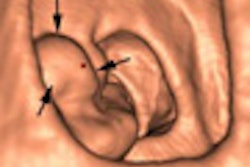VIENNA - Coronary CT angiography (CTA) is proving useful for evaluating most patients with suspected coronary artery disease, particularly since the introduction of 64-slice scanners. At this stage of development, however, there is less information about CTA's performance in various subpopulations, such as obese patients, who represent a big slice of the scanning pie in healthcare facilities throughout the U.S. and Europe.
"As we know, the population of obese patients is officially an epidemic in some Western countries, and others are rapaidly following," said Dr. Rodrigo Salgado in a presentation Tuesday at the European Congress of Radiology (ECR).
"Obese patients have specific challenges: They have multiple risk factors and comorbidities, they are difficult to assess clinically, and ... also it's not so easy to peform conventional angiography due to their body constitution," he said. "It would be nice if CT had some role in the evaluation of these pateints' coronary arteries."
Salgado and his colleagues from University Hospital of Antwerp in Edegem, Belgium, wanted to know if coronary CTA was useful in this population, whether the image quality justified the high radiation dose, and whether the sensivity for coronary artery stenosis dropped as patients' body mass index (BMI) increased.
They performed a restrospective study of 567 patients with a BMI of 30 or greater, who were referred for the exam between June 2005 and August 2007. In all, 567 patients (male predominance) were scanned with a 64-slice CT scanner (LightSpeed VCT, GE Healthcare, Chalfont St. Giles, U.K.) using a retrospectively gated triphasic contrast-enhanced imaging protocol: 0.625-mm collimation, 120 kVp, and ECG-modulated mAs.
"We were a bit surprised by the high number of obese patients we had," Salgado said. "Altogether, one in four to five patients referred for cardiac CT was obese."
The study cohort was divided into three subgroups based on BMI:
- Obesity class I: BMI 30-34, 417 patients, 6,328 total coronary artery segments
- Obesity class II: BMI 35-39, 104 patients, 1,573 segments, average weight of 94 kg (207 lb)
- Morbid obesity, class III:BMI ≥ 40, 46 patients, 696 segments, 8,597 coronary segments
The different patient groups had different results. Between class II and class III patients, "we saw a clear drop in the number of assessable coronary arteries," Salgado said.
For all obesity classes, the average percentage of assessable segments per patient was 94.1% (92.7-95.5), 93.0% (89.4-94.0), and 85.8% (82.6-89.1), Salgado reported.
Analyzed by coronary artery, the left anterior descending (LAD) artery had the largest drop in assessability between class I and class III (from 95.5% to 82.6%), followed by the left circumflex artery (LCX) (from 94.7% to 85.9%).
Analyzed by coronary artery segment (per the 17-segment American Heart Association model), the proximal LAD had the greatest drop in assessability -- from 97.3% to 80.4%, followed by the distal LAD, from 94.7% to 80.4%.
"We found on a per-patient analysis that there is the largest difference between class II and class III, on a coronary artery analysis the largest drop in the LAD and LCX, and on a per-segment basis again the largest drop in the proximal and distal LAD," Salgado said.
The study limitations included its retrospective design; however, a prospective study is under way, he said. One question being addressed in the new project is whether absolute weight is a more important parameter than BMI.
Also, the investigators didn't assess the accuracy of coronary CTA because the focus was on the feasibility of performing coronary CTA in obese patients. The scan protocol was not adapted to each individual patient, which might have improved the results, and heart rate was not addressed, Salgado said.
Finally, the radiation dose for this patient cohort was high -- within the 90th percentile for coronary CTA, Salgado said. The exams yielded a dose-length product of 1,200-1,500 mGy/cm.
"It appears ... that CTA is feasible for class I and class II patients, but it would not be recommended for class III," he concluded. "It remains a high-dose examination; of course, the best dose reduction is adequate patient selection. It is a technical challenge in postprocessing, and it is also a burden on the equipment because you always have to give the highest possible dose."
By Eric Barnes
AuntMinnie.com staff writer
March 11, 2008
Related Reading
Prospective gating drops cardiac CT radiation dose, March 10, 2008
Dose studies delve into coronary CTA, March 8, 2008
Rampant U.S. obesity strains imaging devices, November 28, 2007
Obesity increases radiation dose delivered during atrial fibrillation ablation, July 20, 2007
Obesity forces radiology to supersize, enhance x-ray technology, March 1, 2007
Copyright © 2008 AuntMinnie.com




















